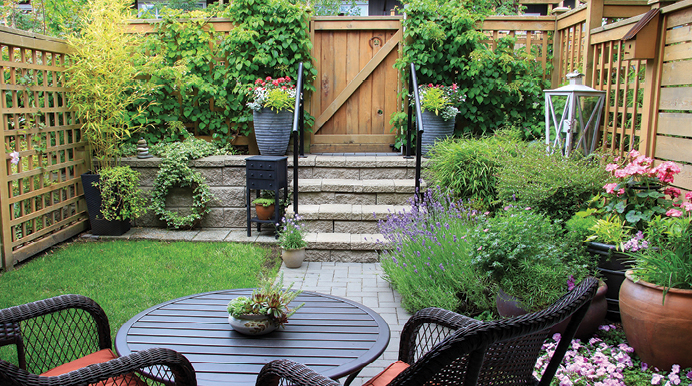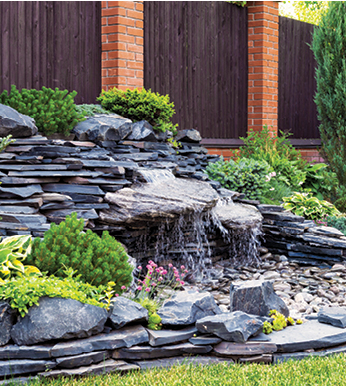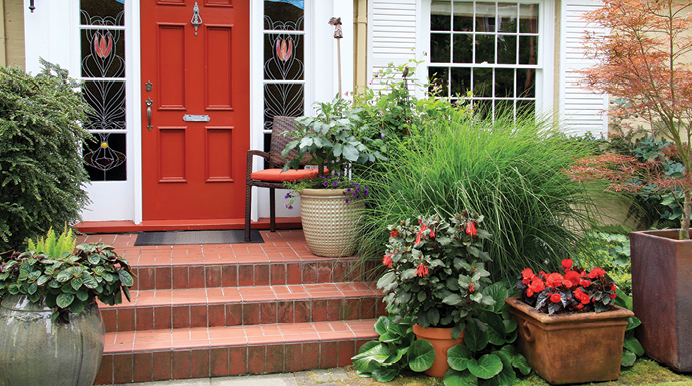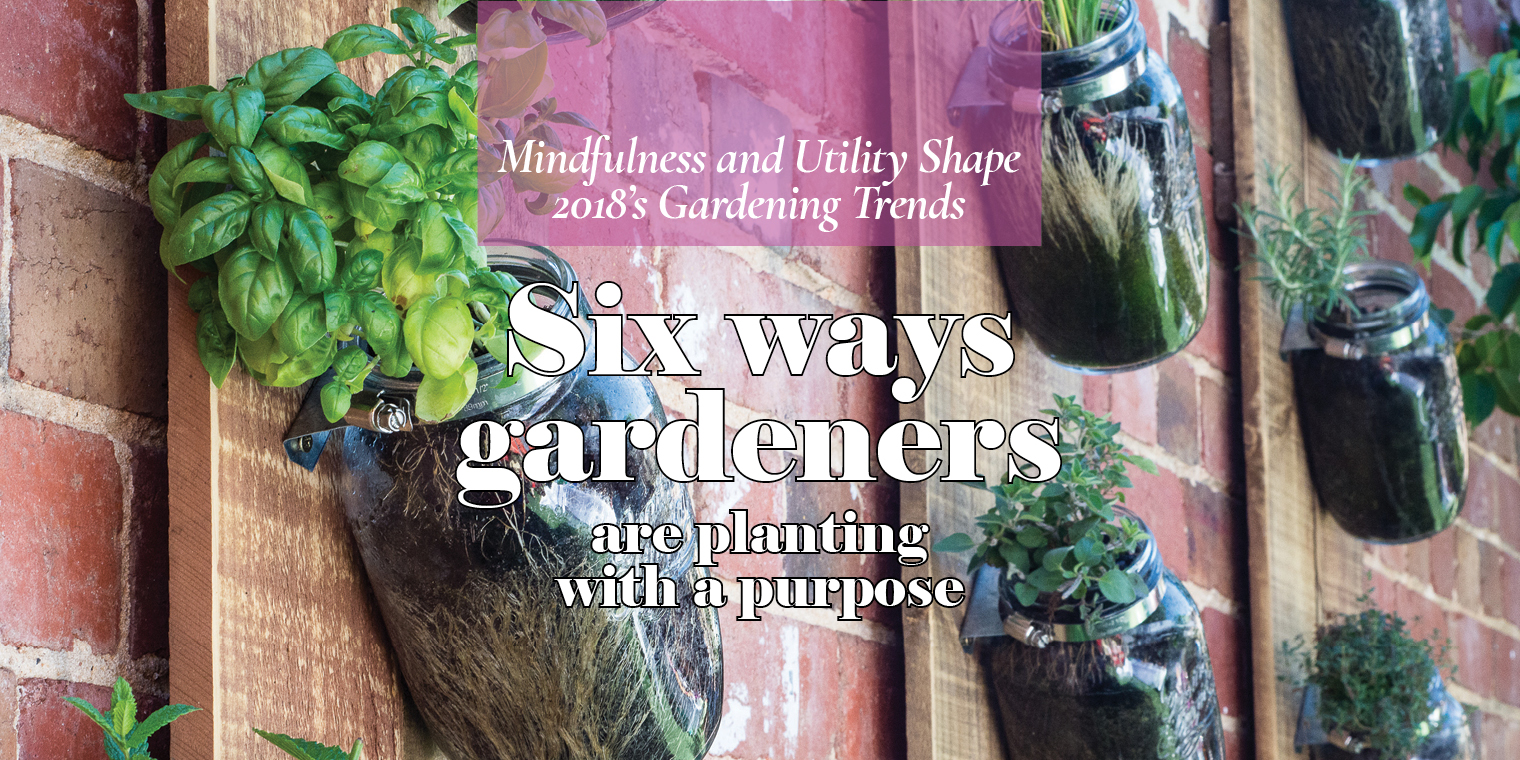Mindfulness and Utility Shape 2018’s Gardening Trends
In 2018, gardens will do much more than provide attractive accents around homes. Environmental concerns and awareness of the calming effects of nature are having a big impact on garden design and plant selection. People are turning to gardens to escape, unplug and rejuvenate their minds by creating private spaces that focus on wellness. Concerns about water and pesticide use, dwindling pollinator populations, and eating a healthy diet also are influencing what people choose to plant and why. Following are six trends to consider when planning your garden.
1. Planting for wellness
People are turning to their gardens as a source of both physical and mental well-being. Gardens provide a calming place to disconnect from our 24/7 digital world and find peace and renewal. According to the Garden Media Group’s 2018 Trends Report, “Gardening is becoming more about creating relaxing spaces.” The trends toward mindfulness and meditation that have emerged over the past few years have extended to the garden, where people are creating “breathing rooms,” using plants to clean the air, clear the mind and escape from day-to-day stress.
Gardens devoted to physical wellness also are gaining popularity. Recent dietary trends have seen people eating less meat and concentrating on a more plant-based diet. As a natural extension of that movement, people are growing more of their own food. If you’re focusing on eating more plants, consider growing protein-rich edibles, such as peas, broccoli, corn, edamame, spinach, kale and sunflowers.
In addition, gardeners are intrigued by the health benefits and color accents afforded by purple foods. Look for berries, purple cabbage, eggplant, black raspberries, purple asparagus and herbs like purple basil to be popular in home gardens in 2018.
2. Cooperative gardening
You may have heard about the dwindling population of bees and butterflies due to disease, loss of habitat and widespread use of pesticides, but Garden Design magazine reports that habitat loss is also impacting birds, frogs and even turtles. As news of this threat to the ecosystem spreads, people are adjusting their garden plans to provide havens for pollinators. Three-quarters of the plants on earth require animals for pollination, and the most important thing gardeners can do is plant pollinator-friendly native species to support local wildlife. Native plants occur naturally in a region and form the ecological basis for the life in that area. To download a guide to native plants in our area, visit www.plantnovanatives.org.
Not only are gardeners choosing plants that cooperate with pollinators, they are also focusing on plants that form a social network. Choosing perennials and self-seeding plants that come back or establish new plants year after year leads to a community of plants that help sustain a healthy environment.
3. A new take on lawns
If the word lawn conjures up an image of an expanse of neatly trimmed, lush green grass, 2018 may get you to rethink that definition. The Garden Media Group’s 2018 Trends Report cited imperfect gardening, or embracing the spirit of the Japanese term wabi-sabi—finding beauty in imperfection—as a rising trend. The report stated that “perfectly maintained lawns are getting less common and sought-after.”
Although traditional lawns may not go away anytime soon, busy schedules mean people have less time to devote to maintaining a manicured lawn, and smaller lawns or lawns that are not grass require less water, thereby preserving resources.
According to Architectural Digest, people are replacing grass lawns with ground covers, tall grasses and even sedge. Groundcovers prevent erosion, don’t need as much water and don’t need to be mowed. The 2018 Trends Report also reported that “growing clover and dandelions in untreated lawns is becoming a status symbol of conservation.”




4. It’s big to go small
Lawns aren’t the only thing shrinking in the garden. To keep gardens in scale with smaller lawns, and because people don’t want to put as much effort or maintenance into their plantings, you will see more dwarf versions of plants going into gardens in 2018. The American Meadows Blog attributes the popularity of dwarf plants to Millennials and retirees who more often live in smaller spaces, so growers are developing dwarf plant varieties to fit with their surroundings.
Another way people are going small is with container gardening. Although not new, the American Meadows Blog predicts that container gardening will become even more popular as city populations increase and yards get smaller. Containers also allow small-scale gardeners to participate in other trends, such as planting for pollinators, growing food or creating an oasis on a patio or balcony. Even gardeners with plenty of space are using containers to decorate porches, entryways, decks and outdoor eating areas.
5. Creating privacy
People not only are turning to their gardens for mental escape, they are using them to physically escape the world as well. Gardeners are turning to plants, rather than fences, to carve out a private outdoor space and to block out noises and eyesores. According to the American Meadows Blog, some gardeners are taking it a step further. “Many aren’t just planting for privacy in their outdoor spaces but are also strategically planting vines and thorny bushes to help with home security.”
6. Bringing the outside in
Although houseplants never really went away, prepare to see them make a big comeback in 2018. You will see potted plants, hanging plants and even terrariums being included as accessories in home design.
In addition to houseplants, indoor food gardening is increasingly popular. This trend allows people to grow and eat fresh food year round, regardless of weather conditions. Gardeners are growing herbs on kitchen windowsills or placing pots of leafy greens, peppers or tomato plants in a sunny spot.






